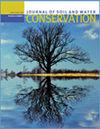Headcut erosion characteristics revealed through simulated rainfall and scouring experiments in the gully region of the Loess Plateau
IF 2.6
4区 农林科学
Q2 ECOLOGY
引用次数: 1
Abstract
Headcut erosion is the main sediment source that may cause severe damage to the ecological environment and agricultural production. The study of headcut erosion characteristics, such as gully headcut morphological evolution and sediment particle transport processes, is essential for understanding the mechanism of gully erosion. A series of simulated rainfall combined scouring experiments with constant rainfall intensity (0.8 mm min–1) and variable flow discharge (3.6, 4.8, 6.0, and 7.2 m3 h–1) were conducted to illustrate the headcut erosion process in the gully region of the Loess Plateau. The results showed that gully width and gully depth increased as time and flow discharge increased. The headcut retreat length increased exponentially with experiment time. The gully head heights decreased by 10, 13, 21, and 26 cm at different flow discharges after 180 min. The contents of clay and silt in eroded sediment particles decreased by 7.97% to 16.59% and 7.98% to 15.34%, respectively, whereas the sand volume fraction increased by 9.33% to 20.04% compared to that of the original soil. The enrichment rates of clay and silt sediment were 0.83 to 0.92 and 0.85 to 0.92, while the enrichment rate of sand sediment was 1.09 under different flow discharges. The critical particle size was 0.0326 mm. The fractal dimension of the eroded sediment particles was 2.61 to 2.67 and showed good agreement with the clay volume fraction, with a coefficient of determination (R2) of 0.93. These results provide a basis for headcut erosion model establishment, ecological management, and soil and water conservation in the gully region of the Loess Plateau.通过模拟降雨和冲刷试验揭示黄土高原沟壑区顶蚀特征
侵蚀是主要的泥沙来源,对生态环境和农业生产造成严重破坏。研究沟头侵蚀特征,如沟头形态演化和泥沙颗粒输运过程,是理解沟头侵蚀机理的基础。采用恒定降雨强度(0.8 mm min-1)和变流量(3.6、4.8、6.0和7.2 m3 h-1)的降雨模拟试验,研究了黄土高原沟壑区头切侵蚀过程。结果表明:沟槽宽度和沟槽深度随时间和流量的增加而增加;头切后退长度随实验时间呈指数增长。180 min后,不同流量下沟头高度分别降低了10、13、21和26 cm,侵蚀泥沙颗粒中粘土和粉砂含量分别降低了7.97% ~ 16.59%和7.98% ~ 15.34%,砂粒体积分数增加了9.33% ~ 20.04%。不同流量下,粘土和粉质沉积物的富集率分别为0.83 ~ 0.92和0.85 ~ 0.92,砂质沉积物的富集率为1.09。临界粒径为0.0326 mm。侵蚀泥沙颗粒的分形维数为2.61 ~ 2.67,与粘土体积分数具有较好的一致性,决定系数(R2)为0.93。研究结果可为黄土高原沟壑区head - cut侵蚀模型的建立、生态治理和水土保持提供依据。
本文章由计算机程序翻译,如有差异,请以英文原文为准。
求助全文
约1分钟内获得全文
求助全文
来源期刊
CiteScore
4.10
自引率
2.60%
发文量
0
审稿时长
3.3 months
期刊介绍:
The Journal of Soil and Water Conservation (JSWC) is a multidisciplinary journal of natural resource conservation research, practice, policy, and perspectives. The journal has two sections: the A Section containing various departments and features, and the Research Section containing peer-reviewed research papers.

 求助内容:
求助内容: 应助结果提醒方式:
应助结果提醒方式:


